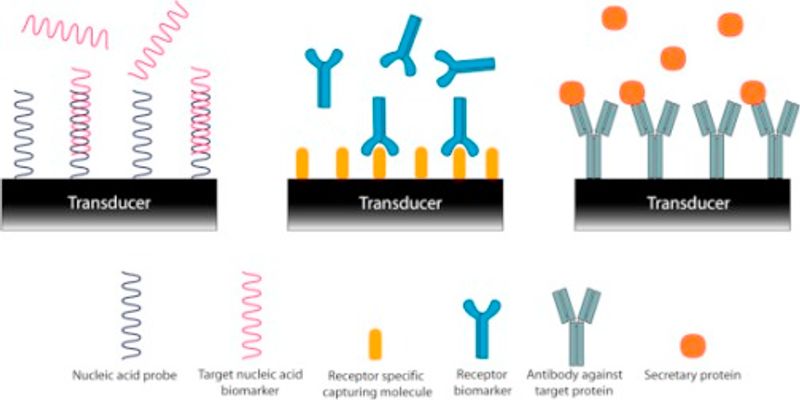Cancer Biomarker
Cancer Biomarker: refers to a substance or process that is indicative of the presence of cancer in the body. A biomarker may be a molecule secreted by a tumor or a specific response of the body to the presence of cancer.
-
MAY 28, 2014 | 6:00 AMFor the last 60 years the primary method of preventing cervical cancer in both the U.S. and Europe has been cervical cytology -- if it is negative, women are rescreen in three years and if po...Speaker: Julia Engstrom-Melnyk, PhDThe therapeutic utility of stem cells is rooted in an understanding -- and exploitation -- of their natural role from earliest development to lifes end. Their job is first to participate in o...Speaker: Evan W. Snyder, M.D., Ph.D., F.A.A.PPresented at: Neuroscience Virtual Event Series 2014
MAR 20, 2014 | 1:00 PM
Using high throughput next-generation sequencing to simultaneously search large number of genes for pathogenic mutations has numerous advantages. It decreases the pressure to narrow the dif...
MAR 20, 2014 | 10:00 AM
When speaking of neurodegenerative diseases, average public is not made aware of the true cost that brain related disorders have on annual budget. The true impact on economy is not usually...
MAR 19, 2014 | 9:00 AM
When speaking of neurodegenerative diseases, average public is not made aware of the true cost that brain related disorders have on annual budget. The true impact on economy is not usually...
FEB 19, 2014 | 9:00 AM
Genome sequencing technologies have enabled a rapid expansion into understanding cancer biology, drug development, and treatment resistance. Research in our laboratory has focused on the app...
Speaker:
Milan Radovich, PhD
NOV 20, 2013 | 11:00 AM
...
Speaker:
Dan Rhodes, PhD
OCT 17, 2013 | 2:00 PM
C.E. CREDITS
Pancreatic cancer is the 4th most common cause of cancer deaths in the United States. Due to the aggressive nature of this cancer and the lack of biomarkers for early detection, the incidence...
Speaker:
Antonio T. Baines, PhD
OCT 17, 2013 | 12:00 PM
The discovery of proteinaceous disease biomarkers and their clinical validation is critically important for the enablement of molecular diagnostics and ultimately, precision medicine. In spit...
Speaker:
Martin Latterich, PhD
OCT 17, 2013 | 11:00 AM
C.E. CREDITS
Curative therapy for metastatic disease in solid malignancies remains frustratingly elusive due to the long recognized problem of tumor cell heterogeneity and emergence of treatment resistant...
Speaker:
George Poste, DVM, DSc, PhD
OCT 17, 2013 | 7:00 AM
RNA-Seq allows the simultaneous observation of gene expression levels, mutations in the coding sequences, splice variants and gene fusions, which are especially important in cancer studies. A...
Speaker:
Michaela Bowden, PhD
OCT 16, 2013 | 12:00 PM
The effective implementation of personalised cancer therapeutic regimens depends on the successful identification and translation of informative biomarkers to aid clinical decision making. Th...
Speaker:
William M. Gallagher, PhD.
OCT 16, 2013 | 10:00 AM
C.E. CREDITS
The current paradigm of detecting established cancer (often too late) and treating routinely with cytotoxic drugs is beginning to change. Advanced technologies such as whole genome sequencin...
Speaker:
Anna Barker, PhD
OCT 16, 2013 | 7:00 AM
C.E. CREDITS
With the rapid rise in the number of therapeutic options for men with castration-resistant prostate cancer (CRPC) comes increasingly complicated treatment decision-making, emphasizing the nee...
Speaker:
Andrew Armstrong, MD ScM FACP
As Chief of Scientific Intelligence at the John Wayne Cancer Institute, Dr. Hoon interacts with external academic, industry, and government agencies to develop innovative translational rese...
AUG 22, 2013 | 7:00 AM
Rheumatoid Arthritis (RA) is a heterogenous disease that affects 1.5% of the population. Similar to cancer, early detection coupled with an effective treatment strategy can significantly impr...
AUG 21, 2013 | 10:00 AM
C.E. CREDITS
Massively parallel sequencing technology has proven to enable the identification of driver genetic alterations in patients' tumors that may be suppressed by targeted therapies. Through retros...
MAY 30, 2013 | 9:00 AM
Survival rates for early stage non-small cell lung cancer (NSCLC) remain unacceptably low compared to other common solid tumors. This mortality reflects a weakness in conventional staging, as...
MAY 30, 2013 | 8:00 AM
VITROS® Microslides utilize a layered, dry-slide technology that enables separate reaction domains such that each step can be optimized to provide excellent assay performance. Excellent preci...
OCT 26, 2011 | 2:00 PM
Autophagy is a normal degradative pathway that involves the sequestration of entire organelles, protein complexes, and misfolded proteins in a membrane vacuole called the autophagosome. The ...
MAY 28, 2014 | 6:00 AM
For the last 60 years the primary method of preventing cervical cancer in both the U.S. and Europe has been cervical cytology -- if it is negative, women are rescreen in three years and if po...
Speaker:
Julia Engstrom-Melnyk, PhD
The therapeutic utility of stem cells is rooted in an understanding -- and exploitation -- of their natural role from earliest development to lifes end. Their job is first to participate in o...
Speaker:
Evan W. Snyder, M.D., Ph.D., F.A.A.P
Presented at: Neuroscience Virtual Event Series 2014
MAR 20, 2014 | 1:00 PM
Using high throughput next-generation sequencing to simultaneously search large number of genes for pathogenic mutations has numerous advantages. It decreases the pressure to narrow the dif...
MAR 20, 2014 | 10:00 AM
When speaking of neurodegenerative diseases, average public is not made aware of the true cost that brain related disorders have on annual budget. The true impact on economy is not usually...
MAR 19, 2014 | 9:00 AM
When speaking of neurodegenerative diseases, average public is not made aware of the true cost that brain related disorders have on annual budget. The true impact on economy is not usually...
FEB 19, 2014 | 9:00 AM
Genome sequencing technologies have enabled a rapid expansion into understanding cancer biology, drug development, and treatment resistance. Research in our laboratory has focused on the app...
Speaker:
Milan Radovich, PhD
NOV 20, 2013 | 11:00 AM
...
Speaker:
Dan Rhodes, PhD
OCT 17, 2013 | 2:00 PM
C.E. CREDITS
Pancreatic cancer is the 4th most common cause of cancer deaths in the United States. Due to the aggressive nature of this cancer and the lack of biomarkers for early detection, the incidence...
Speaker:
Antonio T. Baines, PhD
OCT 17, 2013 | 12:00 PM
The discovery of proteinaceous disease biomarkers and their clinical validation is critically important for the enablement of molecular diagnostics and ultimately, precision medicine. In spit...
Speaker:
Martin Latterich, PhD
OCT 17, 2013 | 11:00 AM
C.E. CREDITS
Curative therapy for metastatic disease in solid malignancies remains frustratingly elusive due to the long recognized problem of tumor cell heterogeneity and emergence of treatment resistant...
Speaker:
George Poste, DVM, DSc, PhD
OCT 17, 2013 | 7:00 AM
RNA-Seq allows the simultaneous observation of gene expression levels, mutations in the coding sequences, splice variants and gene fusions, which are especially important in cancer studies. A...
Speaker:
Michaela Bowden, PhD
OCT 16, 2013 | 12:00 PM
The effective implementation of personalised cancer therapeutic regimens depends on the successful identification and translation of informative biomarkers to aid clinical decision making. Th...
Speaker:
William M. Gallagher, PhD.
OCT 16, 2013 | 10:00 AM
C.E. CREDITS
The current paradigm of detecting established cancer (often too late) and treating routinely with cytotoxic drugs is beginning to change. Advanced technologies such as whole genome sequencin...
Speaker:
Anna Barker, PhD
OCT 16, 2013 | 7:00 AM
C.E. CREDITS
With the rapid rise in the number of therapeutic options for men with castration-resistant prostate cancer (CRPC) comes increasingly complicated treatment decision-making, emphasizing the nee...
Speaker:
Andrew Armstrong, MD ScM FACP
As Chief of Scientific Intelligence at the John Wayne Cancer Institute, Dr. Hoon interacts with external academic, industry, and government agencies to develop innovative translational rese...
AUG 22, 2013 | 7:00 AM
Rheumatoid Arthritis (RA) is a heterogenous disease that affects 1.5% of the population. Similar to cancer, early detection coupled with an effective treatment strategy can significantly impr...
AUG 21, 2013 | 10:00 AM
C.E. CREDITS
Massively parallel sequencing technology has proven to enable the identification of driver genetic alterations in patients' tumors that may be suppressed by targeted therapies. Through retros...
MAY 30, 2013 | 9:00 AM
Survival rates for early stage non-small cell lung cancer (NSCLC) remain unacceptably low compared to other common solid tumors. This mortality reflects a weakness in conventional staging, as...
MAY 30, 2013 | 8:00 AM
VITROS® Microslides utilize a layered, dry-slide technology that enables separate reaction domains such that each step can be optimized to provide excellent assay performance. Excellent preci...
OCT 26, 2011 | 2:00 PM
Autophagy is a normal degradative pathway that involves the sequestration of entire organelles, protein complexes, and misfolded proteins in a membrane vacuole called the autophagosome. The ...



















